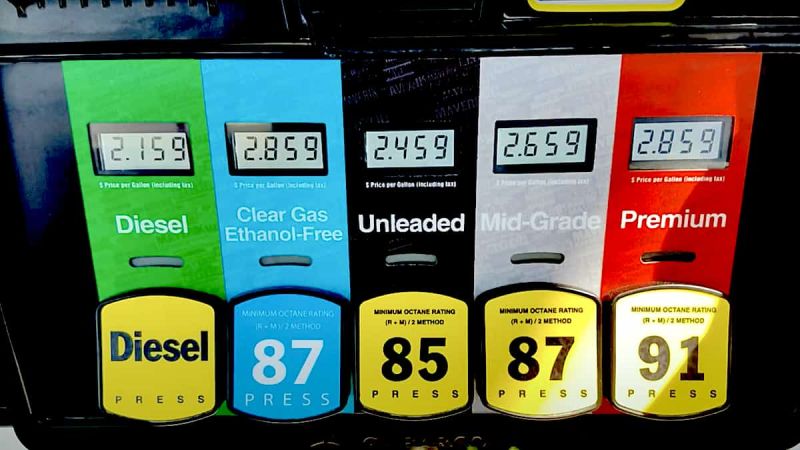Ford F-150 Manual Warning
According to the 2021 Ford F-150 owner’s manual, it advises its owners that the F-150 operates on regular unleaded gasoline with a minimum pump (R+M)/2 octane rating of 87. However, in some areas, the regular unleaded octane rating is below 87. Ford warns in the manual that by using lower octane gas, that engine damage could result that will not be covered by the vehicle warranty!
An Informative Must-Watch Video
News of Ford’s F-150 manual warning was recently posted in the ever-popular Engineering Explained YouTube channel video, that addresses what is going on why you should never use some gasoline types in your car.
In the video, you will learn:
• What the octane numbers mean.
• Why “knock, knock” is not a joke in your engine.
• Why your elevation changes things in your octane numbers and engine performance.
• How old data is driving new car warranties.
• Are octane numbers likely to be a problem with your car?
• What is the worst case scenario with the new Ford F-150?
• Can Ford technically and legally deny your warranty coverage?
That said, here is the video in its entirety:
Never Use This Gas In Your Car!
And finally...
For more Engineering Explained car video articles, be sure to check out the following linked articles that offer some very useful and entertaining information on engine performance such as these two popular “Subaru Crosstrek Engine Oil Analysis After 3,000 Mile Test; and, “Doing The Math on a Tesla Roadster 0-60 in 1.1 Seconds Claim and What Was Determined” articles.
Regarding other Ford vehicles, find out Why It’s So Easy to Pick the Lock on a Ford Explorer; and, How Ford is a Big Player in the Latest and Most Modified Police Supercars in the U.S.
COMING UP NEXT: Toyota Care Dealership Service Center Mistakes
Timothy Boyer is Torque News automotive reporter based in Cincinnati. Experienced with early car restorations, he regularly restores older vehicles with engine modifications for improved performance. Follow Tim on Twitter at @TimBoyerWrites for daily automotive-related news.












Comments
Two things going on here.
Permalink
Two things going on here. One, is to let price determine what grade gasoline you put in your vehicle. Two, people need to read the owner's manual for basic info on preventative maintenance. Most vehicles today tell you when it is time for an oil change, at least my Chevrolet and Buick do. Also read fuel requirements, a minimum octane rating for your vehicle. But I'm a motor head from the '60's, so I do this instinctively. My holy grail Camaro is a 1969 Z-28, hugger orange, with a M-22 "rock crusher" 4-speed transmission. A factory-built race car for sure.
A 1968 hemi dart is a factory
Permalink
In reply to Two things going on here. by Jesse (not verified)
A 1968 hemi dart is a factory hot rod a 1964 ford thunderbolt is a hot rod both can turn the quarter in low 11 seconds .a z/28 camaro could not run with either of those cars if you pulled 2 spark wires off .lol
The camaro was built for SCAA
Permalink
In reply to A 1968 hemi dart is a factory by Jeremy Kirk (not verified)
The camaro was built for SCAA track racing, not 1/4 mile. Neither of those cars could come close to the camaro on the track. Seems like you don't know much about racing.
Jesse, I see a different
Permalink
Jesse, I see a different thing going on here- greed. Gasoline is usually 87 octane for regular- check out cars to know, that is the standard. 89 is mid-grade and 91 or above is hi-test or premium. Wherever the picture of this article is from shows a shell game fuel company maneuver- note the prices. They know darn well that cars are designed for 86/87 octane.
85 octane is what's normally
Permalink
85 octane is what's normally offered in high altitude states, like CO for example. It has ethanol added to it. It works just the same as 87 octane at lower elevations. Remember, thinner air, means less fuel needed. Whoever wrote this article probably lives at sea level and has no idea what us mile-high'r people do on daily basis. Granted, vehicles like the new F-150 have engines that are turbo'ed or twin turbo'ed that require premium fuel. So yes, 85 is not recommended regardless of altitude.
Cars haven't needed lower
Permalink
In reply to 85 octane is what's normally by Trey F (not verified)
Cars haven't needed lower octane since carbureted days. 85 octane should not even be offered anymore...regardless of elevation. The US Department of Energy also recommends that you fill your tank with the manufacturer specified octane, regardless of elevation. Will 85 "damage" the engine, probably not, but at this point with engines being so well tuned regarding electronic ignitions, and timing...why even take the chance?
All good points with above
Permalink
All good points with above comments. I still say read the owner's manual. It is essential to know what the manufacturer recommends for fuel requirements. This is especially important if a vehicle has more that one engine in the line-up. At one time the Chevrolet Equinox had two 4-cylinder engines in the line-up. One took regular, the turbo took premium. In my area of the country, the more ethanol in the gasoline, the cheaper it is per gallon. So if someone is shopping on price alone, it is possible to put a flex fuel only product in one's vehicle, thinking they have saved a few pennies. Only to have a big repair bill for the oversight. I'll be the first to say that gas pumps with 4 or 5 hoses can be foreboding. The consumer just has to be aware of all the variables in choosing which product to put in the gas tank and choose the right one. Good talk y'all.
OIL AND GAS AVAILABLE ON CIF
Permalink
OIL AND GAS AVAILABLE ON CIF/FOB
We have all kinds of petrochemical products Such as Jet fuel, A1 & JP54, EN590 10ppm, D2, D6, LNG, LPG, LCO, UREA46% ETC. All available for urgent lift CIF/FOB
Contact me on email for Soft Offer
Popov Alexanda
Tel.: +7 (906) 508 7981
Email: [email protected]
Email: [email protected]
Skype: [email protected]
I am in fact grateful to the…
Permalink
I am in fact grateful to the owner of this web site who has shared this great piece of writing at at this place.